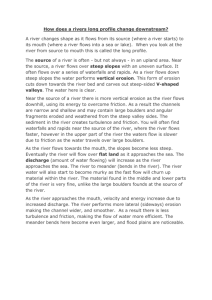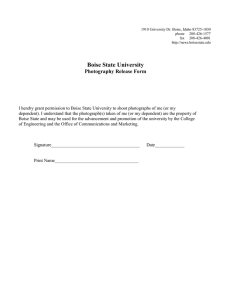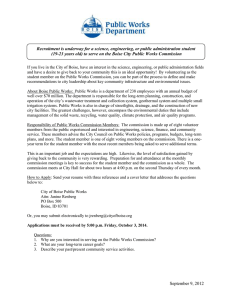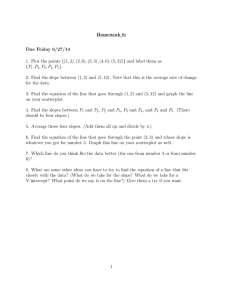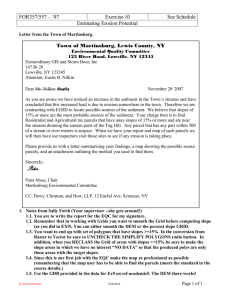THE BOISE FRONT, IDAHO Samuel N. Mattise Gerald Scholten ~C~CALCONTROLOF
advertisement
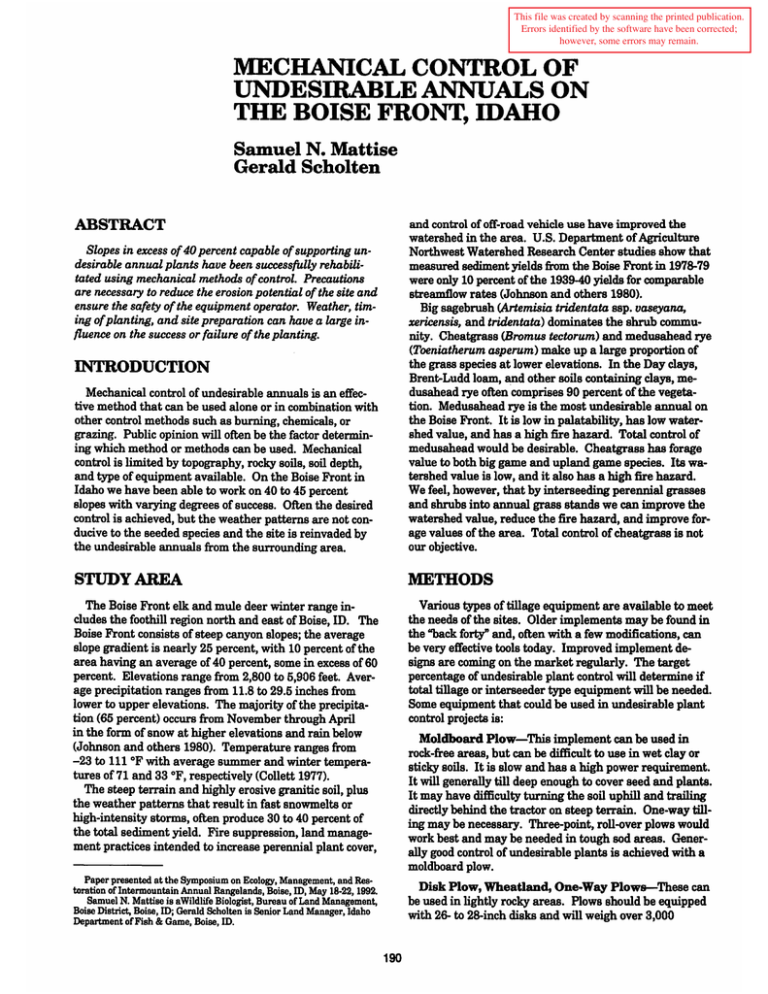
This file was created by scanning the printed publication. Errors identified by the software have been corrected; however, some errors may remain. ~C~CALCONTROLOF UNDES~LEANNUALSON THE BOISE FRONT, IDAHO Samuel N. Mattise Gerald Scholten ABSTRACT Mechanical control of undesirable annuals is an effective method that can be used alone or in combination with other control methods such as burning, chemicals, or grazing. Public opinion will often be the factor determining which method or methods can be used. Mechanical control is limited by topography, rocky soils, soil depth, and type of equipment available. On the Boise Front in Idaho we have been able to work on 40 to 45 percent slopes with varying degrees of success. Often the desired control is achieved, but the weather patterns are not conducive to the seeded species and the site is reinvaded by the undesirable annuals from the surrounding area. and control of off-road vehicle use have improved the watershed in the area. U.S. Department of Agriculture Northwest Watershed Research Center studies show that measured sediment yields from the Boise Front in 1978-79 were only 10 percent of the 1939-40 yields for comparable streamflow rates (Johnson and others 1980). Big sagebrush (Artemisia tridentata ssp. vaseyana, xericensis, and tridentata) dominates the shrub community. Cheatgrass (Bromus tectorum) and medusahead rye (Toeniatherum asperum) make up a large proportion of the graBS species at lower elevations. In the Day clays, Brent-Ludd loam, and other soils containing clays, medusahead rye often comprises 90 percent of the vegetation. Medusahead rye is the most undesirable annual on the Boise Front. It is low in palatability, has low watershed value, and has a high fire hazard. Total control of medusahead would be desirable. CheatgraSB has forage value to both big game and upland game species. Its watershed value is low, and it also has a high fire hazard. We feel, however, that by interseeding perennial graBBes and shrubs into annual grass stands we can improve the watershed value, reduce the fire hazard, and improve forage values of the area. Total control of cheatgrass is not our objective. STUDY AREA METHODS The Boise Front elk and mule deer winter range includes the foothill region north and east of Boise, ID. The Boise Front consists of steep canyon slopes; the average slope gradient is nearly 25 percent, with 10 percent of the area having an average of 40 percent, some in excess of 60 percent. Elevations range from 2,800 to 5,906 feet. Average precipitation ranges from 11.8 to 29.5 inches from lower to upper elevations. The mlijority of the precipitation (65 percent) occurs from November through April in the form of snow at higher elevations and rain below (Johnson and others 1980). Temperature ranges from -23 to 111 °F with average summer and winter temperatures of71 and 33 °F, respectively (Collett 1977). The steep terrain and highly erosive granitic soil, plus the weather patterns that result in fast snowmelts or high-intensity storms, often produce 30 to 40 percent of the total sediment yield. Fire suppression, land management practices intended to increase perennial plant cover, Various types of tillage equipment are available to meet the needs of the sites. Older implements may be found in the "back forty" and, often with a few modifications, can be very effective tools today. Improved implement designs are coming on the market regularly. The target percentage of undesirable plant control will determine if total tillage or interseeder type equipment will be needed. Some equipment that could be used in undesirable plant control projects is: Slopes in excess of 40 percent capable of supporting undesirable annual plants have been successfully rehabilitated using mechanical methods of control. Precautions are necessary to reduce the erosion potential of the site and ensure the safety of the equipment operator. Weather, timing ofplanting, and site preparation can have a large influence on the success or failure of the planting. INTRODUCTION Moldboard Plow-This implement can be used in rock-free areas, but can be difficult to use in wet clay or sticky soils. It is slow and has a high power requirement. It will generally till deep enough to cover seed and plants. It may have difficulty turning the soil uphill and trailing directly behind the tractor on steep terrain. One-way tilling may be necessary. Three-point, roll-over plows would work best and may be needed in tough sod areas. Generally good control of undesirable plants is achieved with a moldboard plow. Paper presented at the Symposium on Ecology, Management, and Restoration of Intermountain Annual Rangelands, Boise, ID, May 18-22, 1992. Samuel N. Mattise is aWildlife Biologist, Bureau of Land Management, Boise District, Boise, ID; Gerald Scholten is Senior Land Manager, Idaho Department ofFish & Game, Boise, ID. Disk Plow, Wheatland, One-Way Plows-These can be used in lightly rocky areas. Plows should be equipped with 26- to 28-inch disks and will weigh over 3,000 190 pounds. The plow has to be set at the maximum angle, usually 40-45 degrees (Hull and others 1952). This equipment will have trouble trailing on steeper slopes, and you may have to plow one-way. Moderate power supplies are needed. implement is best used for erosion control on the contour. Furrows work best on slopes less than 10 percent and rock free. A high power supply is needed. Rails (A-Frame, Supp, Olson, Monte Cristo)These are used mainly for shrub control, where there is a desire to limit damage to grasses and forbs. They have a low to moderate power requirement. Heavy Off-Set Disk-This is probably the most common implement used to control undesirable grasses. It will handle some rock if care is used. Notched disks will cut better than smooth ones, but break more easily. The maximum angle is necessary to achieve the preferred 4 to 6 inches of penetration. Disk diameter ranges from 28 to 50 inches, and weight is approximately 500 pounds per foot (Larson 1980). A high power supply is needed. Harrows (Self-Cleaning or Pipe), Dixie DragsThese mainly accomplish shrub control with a small amount of disturbance to grass and forbs. They have a low power requirement. Roto-Beaters-These are used for shrub or heavier vegetation control. They spread litter over the ground and require a low power supply. Brushland or Rangeland Plow-This plow was developed by the USDA Forest Service Equipment Development Center at San Dimas, CA It is based on the Australian Stump-Jumper plow for moderately rocky, uneven terrain. Paired spring-mounted disks, one 24 and one 28 inches at a 4-degree incline, allow each pair to rise over rocks and brush independently of the others. It is 10 feet wide, weighs 6,000 pounds, and cuts 4 inches deep. The draft angle of the plow is adjustable from 30 to 40 degrees. It is heavy and can withstand some abuse (Larson 1980). A moderate power supply is needed. Chaining or Cabling-Mainly used for removal of woody material. Some grass and forbs are removed if railroad iron is welded to the anchor chain. This equipment can be used effectively on slopes to 50 percent (Plummer and others 1970). The power requirement is high for chain, moderate for steel cable. Although most of the equipment mentioned was developed in the past, modification, additions, and some redesigning of older implements can save many dollars in the tight budgets of today. Disk Chain-A disk chain consists of 24-inch disks bolted to links of anchor chain. A packer-type seeder follows the chain and is used to maintain the disks' distance apart. It prepares a 3- to 4-inch-deep seedbed and plants the area in one pass. It is limited by steep, rocky, or wet soils (PeDant 1990). A moderate power supply is needed. CONTROL CONSIDERATIONS Total control of undesirable annuals strictly by mechanical means often requires several tillages, which reduces the roughness of the tilled surface and reduces the amount of surface litter. This increases the potential for erosion. Use of chemicals or fire before tillage will achieve better control with fewer tillages and lessen the erosion potential, especially on slopes over 30 percent. Hull and others (1958) stated that "in general, plowing should not be attempted on slopes steeper than 20 percent because of the potential increase for erosion." We feel that if proper precautions are taken, as described here, 45-percent slopes can be tilled. Chaining has been an effective method for reducing competition from shrubs and trees and to release suppressed plants or seeded plants on slopes as steep as 50 percent in Utah (Plummer and others 1968, 1970). Undesirable annuals on the steep or rocky slopes may not be effectively controlled by the chain, even with rails attached to the links. After chaining, sufficient litter is left on the ground to help protect the soil from erosion. To reduce the erosion potential, the tillage and seeding must follow the contours. Strip farming or filter strips can also be effectively used to catch run-off if it occurs. Small check dams may be necessary in drainages to help trap sediment. Contour trenches are very effective, but leave a visual scar on the land that may not be accepted by the public. If possible, filter strips, planting sites, and contours should also be made to blend in with the environment to reduce negative visual impacts. The tillage has to be at least 4 inches deep, with 6 inches preferred, to bury the undesirable plants and seed bank to prevent their growth or germination. On Pitting Disk Plow-This is a modified one-way or wheatland disk plow with portions of the disks cut out. The disks alternately contact the ground leaving portions of the soil undisturbed. The pitted area traps the runoff, thus increasing forage production. Control of undesirable annuals is limited to the pitted area only. This is a good tool for erosion control on steeper slopes (Larson 1980). A moderate power supply is required. Chisel Plow and Rippers-These can be used to fracture compacted soil or hardpans. Improved water and nutrient infiltration can increase plant production. They are not effective tools to control undesirable annual plants. They can be used after chemical, fire, or grazing controls to prepare the seedbed. They have a high power requirement. Interseeders---These are mainly used for short-term control of undesirable plants while desirable species get established. Fair control of undesirable plants in the scalped strip is usually achieved. Interseeders are modified fire plows, bulldozer blades, v-blades, and the South Dakota interseeder. The v-blades and bulldozer blades are used on the Boise Front to interseed shrubs. They have a high power requirement. Contour Furrower-This implement uses rippers to break up compacted soil, followed by disks to form furrows. The furrows are diked at intervals, and the seed is broadcasted into the furrows. Some control of undesirable plants in the furrows is obtained, but no control occurs in the 5-foot untouched area between the furrows. This 191 the Boise Front we have found that one tillage has not effectively controlled the undesirable plants, largely because the tillage equipment does not consistently cut deep enough to bury the seed. Improper cutting depth may be caused by equipment failing to trail properly, shallow rocky soil, too dry soil, or equipment improperly adjusted. One-way tilling may be necessary to keep equipment trailing properly. Tillage must be done at a time when the undesirable plants are most susceptible to control. Spring tillage prior to seed ripe, followed by a fall seeding, is recommended by Plummer and others (1968) and Pellant (1990). For better undesirable plant control, we recommend tilling in the spring prior to seed ripe, followed by a fall tillage after annual seed germination. The seeding should be completed in the late fall just prior to the ground freeze. One must remember that the objective of preparing an area for rehabilitation is to disturb the site as little as possible, remove the competing vegetation, and prepare a good seedbed. Use of fire, chemicals, or grazing could be substituted for the spring tillage followed by the fall seedbed preparation tillage and seeding. The seeding must be completed late enough in the fall so cold temperatures will allow seeds to germinate. Tillage on steep slopes can generate numerous problems usually not encountered or encountered to a lesser degree on flatter ground. The potential for accidents with the equipment increases, especially with inexperienced equipment operators. The equipment, especially the older types, may not trail properly behind the tractor. Because of improper trailing, some of the slopes may have to be tilled in one direction, which increases the cost considerably. Regarding increased cost for tillage, Plummer and others (1955) stated that "except for watershed protection, it may not be economically feasible to treat and plant slopes in excess of 30 percent." Even on grades above 20 percent, the cost is much greater than on level ground because large equipment cannot be used and you must resort to small machinery. However, in 1961 Plummer and others (1970) were effectively rehabilitating slopes up to 50 percent, which was previously regarded as impossible to do. They used the anchor chain at an approximate cost of $6 per acre, which was slightly above the average in Utah at that time. In 1987 the modified disk chain used on flat ground in southwestern Idaho had an average cost of $8.50 per acre. This modified disk chain is also equipped with a seeder (Pellant 1988). Cornering or turning around at ends of rows may present erosion problems especially with older implements without hydraulics. Three-point implements or ones equipped with hydraulics for lifting the tool out of the soil will create less problems on the turns. We concur with Koehler (1975), A. C. Hull and others (1964), and Plummer and others (1968) that before starting any undesirable plant control or rehabilitation project certain considerations must be met. (1) Is the change in plant cover necessary and desirable? Will it be worth the expense? (2) What are the erosion factors? What steps will have to be taken to keep erosion at a minimum? (3) Can success be expected? Soils, precipitation, timing of planting, and control of competition need to be considered. (4) Does the available equipment match the reba- bilitation requirement? (5) Can the area be properly managed after the site is rehabilitated? and (6) What effect will the project have on other uses? RECOMMENDATIONS Mechanical control of undesirable plants and rehabilitation of steep slopes (40 to 45 percent) can be accomplished with a minimum of erosion. Precautions for erosion prevention need to be considered in the planning process as well as during implementation of the work. Contour trenching, strip farming, filter strips, check dams, working on the contour, and ripping 6 to 16 inches on the contour are all methods to reduce erosion. The most effective erosion control methods will depend on slope steepness, type of equipment to be used, the amount of soil disturbance, soil type, and expected precipitation. Working on the contour is highly recommended when using any tillage-type equipment. Chaining and cabling up and down slopes where belowsurface disturbance is minimal and sufficient litter is left to protect the site can be accomplished with a minimal amount of erosion. One must remember that these ecological systems are fragile and that even when precautions for erosion are being taken there is still a chance that something may go wrong. Combinations of control methods for undesirable plants should be considered. Burning, chemical application, and grazing combined with mechanical control can be used effectively to achieve the project objectives. Projects involving mechanical control of undesirable plants on steep slopes continue to provide new and valuable information. Every project has a different set of problems and with its completion we gain a little more knowledge. Safety considerations are of utmost importance when working on steep slopes. This includes safety for the personnel involved ·and also for the soil. Steepslope rehabilitation can and will be done to benefit and improve the quality of the land resources. REFERENCES Hull, A C.; Doran, Clyde W.; Wasser, C. H.; Hervey, D. F. 1952. Reseeding sagebrush lands of western Colorado. Fort Collins, CO: Colorado Agricultural and Mechanical College. 27 p. Hull, A. C., Jr.; Doran, Clyde W.; McGinnies, W. J. 1958. Seeding Colorado rangelands. Fort Collins, CO: Colorado State University Experiment Station. 46 p. Hull, A. C.; Holmgren, Ralph C. 1964. Seeding southern Idaho rangelands. Res. Pap, INT-10. Ogden, UT: U.S. Department of Agriculture, Forest Service, Intermountain Forest and Range Experiment Station. 31 p. Johnson, Clifton W.; Secrist, Glen M.; Scholten, Gerald C.; Baum, Robert J. 1980. Watershed management in action on the Boise Front. In: Symposium on watershed management 1980: proceedings; 1980 July 21-23; Boise, ID: 998-1011. Koehler, David A 1975. A review of the literature on reseeding sagebrush-bunchgrass ranges in the semi-arid Western United States. Wildl. Res. Rep. 4. Corvallis, OR: Oregon Wildlife Commission. Federal Aid to Wildlife Restoration Project W-53-R. 47 p. 192 Larson, John E. 1980. Revegetation equipment catalog. Missoula, MT: U.S. Department of Agriculture, Forest Service, Equipment Development Center. 197 p. Pellant, Mike. 1988. Use of disk chain on southern Idaho's annual rangeland. In: Vegetative Rehabilitation and Equipment Workshop; 42d annual report; 1988 February 21-22; Corpus Christi, TX. Missoula, MT: U.S. Department of Agriculture, Forest Service, Missoula Technology Development Center: 40. Pellant, Mike. 1990. The cheatgrass-wildfire cycle-are there any solutions? In: McArthur, E. D.; Romney, E. M.; Smith, S.D.; Tueller, P. T., comps. Proceedingssymposium on cheatgrass invasion, shrub die-off, and other aspects of shrub biology and management; 1989 April 5-7; Las Vegas, NV. Gen. Tech. Rep. INT-276. Ogden, UT: U.S. Department of Agriculture, Forest Service, Intermountain Research Station: 11-18. Plummer, A Perry; Hull, A. C., Jr.; Stewart, George; Robertson, Joseph H. 1955. Seeding rangelands in Utah, Nevada, southern Idaho and western Wyoming. Agric. Handb. 71. Washington, DC: U.S. Department of Agriculture, Forest Service. 73 p. Plummer, A. Perry; Christensen, Donald R.; Monsen, Stephen B. 1968. Restoring big-game range in Utah. Publ. 68-3. Salt Lake City, UT: Utah Division of Fish & Game.183p. Plummer, A. Perry; Christensen, Donald R.; Stevens, Richard; Hancock, Norman V. 1970. Paper presented at 50th Annual Conference of Western Association of State Game and Fish Commissions, July 15, 1970. 12 p. 193


